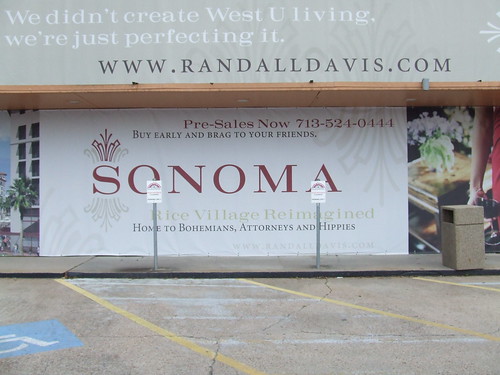Ready or not, here it comes…
After much discussion, which mostly consisted of many plaudits to Council Member Anne Clutterbuck for her work during the decisionmaking process, the Hippie Bohemian Attorney project got the green light.
City council approved the sale of a block of Bolsover Street, between Kelvin and Morningside. The developer plans to build high rise condos, retail, and office spaces. It’s a plan not everyone is happy about.
[…]
This is the latest project by developer Randall Davis, who has spent months trying to convince elected leaders that selling the street is the right move for Rice Village. Today city council agreed, voting in favor of selling the street for $1.5 million.
“There is a preference right now for many people to live in high rise structures,” explained Mayor Bill White. “That’s not all bad. That can be good for the city.”
Getting the city to sell this block of Bolsover was the last major hurdle for Randall Davis, but even people who are considering buying into the Sonoma dream aren’t sure the city should have given in.
Potential homeowner Burt Branstetter said, “I don’t know. It could create some problems in the village, but it’s going to happen. So the question for us, it’s a nice place do we want to live there or not?”
The most interesting comment made during the discussion period was by Council Member/Radio Mogul Michael “Senioritis” Berry, who chided preservationists and transit proponents for complaining when shiny new highrise development is proposed in established neighborhoods. His point, and he used the impending changes to the River Oaks Shopping Center as an example, is that successful transit depends on density, and density often means the kind of development that gets people who should welcome it bent out of shape. While there’s merit to what he said, his choice of example was odd, since it’s not like a Barnes & Noble bookstore is going to contribute to density in a meaningful way. And for what it’s worth, for as much as everybody talked about the parking issues in the Rice Village, which folks who live in the area fear will be exacerbated by the Sonoma project despite their promise to build 40 public parking spaces, nobody said anything about possible non-car alternatives for the area. Oh, well.
KHOU gives a quote to the Council member who was most on the spot over this:
“So you can see why people are very passionate about this because change is coming to the village and none of us really like change,” said Anne Clutterbuck with Houston City Council.
Everyone who spoke during the discussion period was effusive in praising Clutterbuck for making the process transparent and open to the stakeholders. It’ll be interesting to see if this is a campaign issue for her this fall, since she did ultimately have to pick a side. I can’t tell yet how upset the folks who didn’t get their desired outcome from this are. We’ll see.


since it’s not like a Barnes & Noble bookstore is going to contribute to density in a meaningful way.
Sure it is.
Retail that goes UP is retail that does not sprawl across single-level strip centers. Parking garages that go UP is parking that does not sprawl across land (and grass and trees).
It’s more dense development, which is what many people say they want (in some neighborhoods, but not others, apparently).
Yes, “up” is denser than “out”, but that’s not my point here. I don’t think the B&N is going to make the area denser in any meaningful way than what was already there.
I’m sure the new B&N will bring more people to the area, but if they’re simply driving there for the sole purpose of shopping at B&N, that has nothing to do with density. Congestion maybe, but not density. Is there anything to suggest that people, once they’ve driven in and parked in the new garage, will leave the car there while they walk from the B&N to other places in the center? Maybe Weingarten has such data, but if so they sure haven’t made it public.
Finally, to address your typically snide final paragraph, what most people are objecting to here is Weingarten taking something rare and unique to Houston and replacing it with something ubiquitous and generic. You don’t have to engage the merits of dense development to have a problem with that.
As much as the project sounds, aesthetically, like a bobo nightmare in the making, the basic idea – add density to an already dense and well-utilized area – is a good one.
There are several buses that run through the area; maybe the folks in Rice Village should lobby Metro for more service? Or do bohemians and hippies not take the bus?